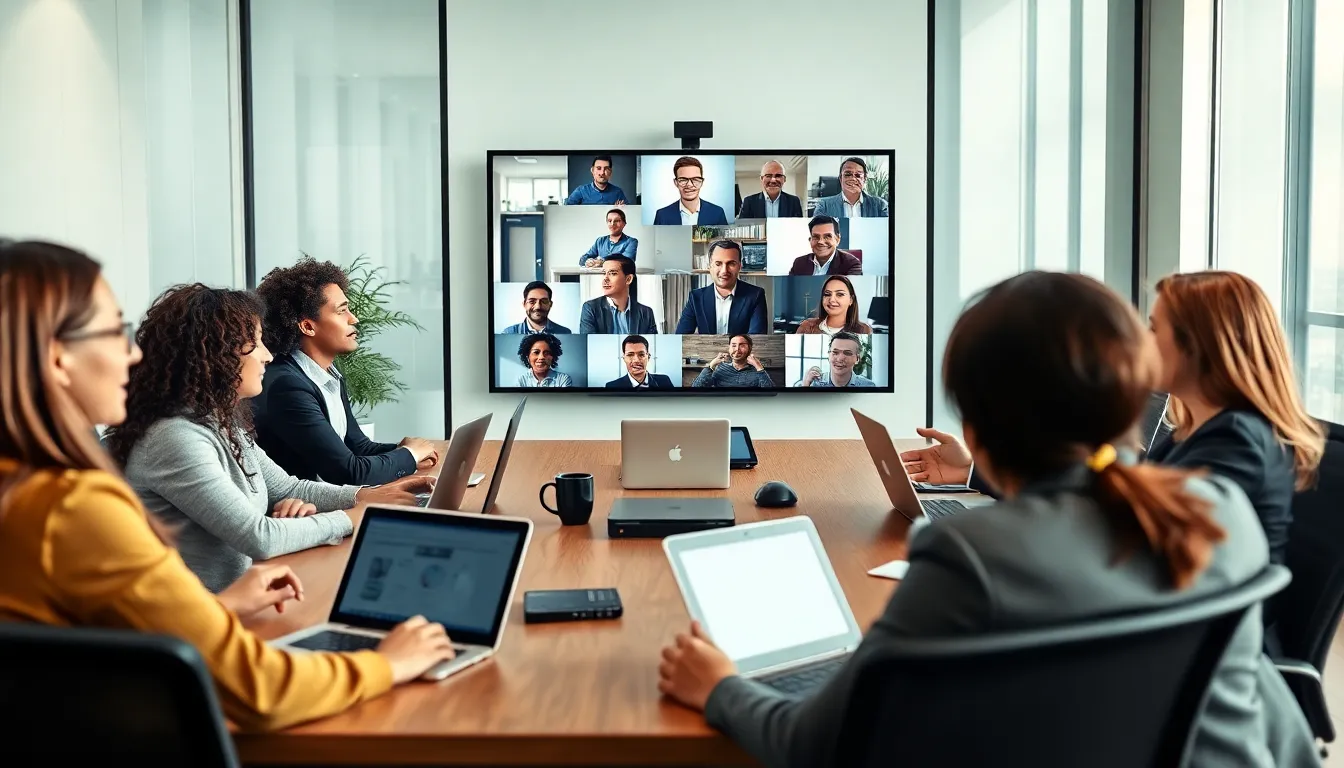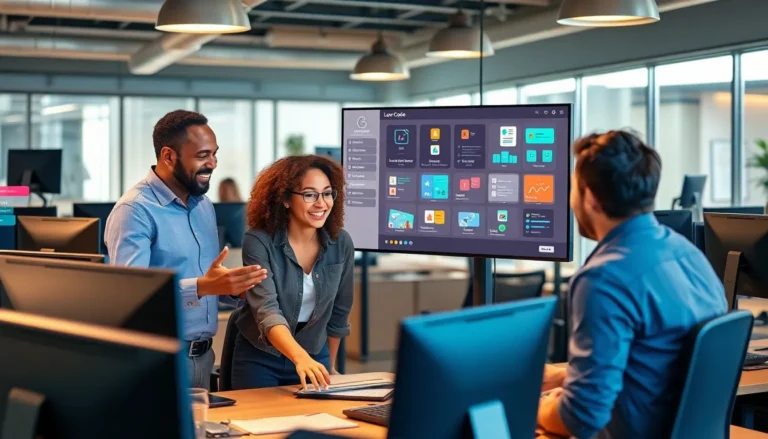Table of Contents
ToggleIn a world where “you’re on mute” has become the unofficial motto of remote work, secure video conferencing for agencies is more crucial than ever. Agencies need to connect with clients and teams seamlessly while keeping sensitive information locked tighter than a squirrel’s secret stash. With cyber threats lurking around every digital corner, it’s time to level up those virtual meetings.
Imagine hosting a client call without worrying if a sneaky hacker is listening in like an overzealous reality TV producer. Secure video conferencing not only enhances communication but also builds trust. Agencies can focus on what they do best—crafting brilliant strategies—while knowing their conversations are safe and sound. So grab your favorite mug, settle in, and let’s dive into the world of secure video conferencing that’s as safe as it is effective.
Importance Of Secure Video Conferencing For Agencies
Secure video conferencing serves as a critical component for agencies in the modern work environment. Protecting sensitive information becomes paramount as agencies increasingly rely on virtual meetings. Utilizing encryption safeguards communication from unauthorized access, ensuring confidentiality.
Fostering trust with clients and stakeholders enhances relationships. When agencies implement secure solutions, it demonstrates a commitment to privacy and data protection. Clients feel more confident collaborating when they know their information remains safe.
Furthermore, maintaining compliance with regulations adds another layer of significance. Agencies often operate under strict guidelines governing data security. Adhering to these regulations through secure video conferencing platforms mitigates the risk of potential legal issues.
Enhancing communication efficiency also plays a vital role. Robust secure video conferencing tools often offer features like screen sharing and file transfer, improving collaboration. Instant access to visuals and documents streamlines discussions, making meetings more productive.
Agencies may also experience significant cost savings through secure video conferencing. Reducing the need for in-person meetings cuts travel expenses. Furthermore, time saved from quicker meetings translates into more efficient workflows.
Secure video conferencing empowers agencies to protect vital information while improving collaboration. Strengthening communication, fostering trust, ensuring compliance, and saving costs establish its importance in today’s digital landscape.
Key Features Of Secure Video Conferencing

Secure video conferencing platforms incorporate several essential features. These elements contribute to safeguarding information and enhancing collaboration for agencies.
End-to-End Encryption
End-to-end encryption ensures that only participants can access meeting content. This feature protects video, audio, and data from interception during transmission. Agencies benefit significantly from this level of security, as confidential information remains private. Implementing strong encryption protocols deters potential cyber threats and fosters a safe communication environment. ISO/IEC 27001 certification reinforces trust in these security measures, signaling robust data protection practices.
User Authentication
User authentication verifies the identity of participants before granting access to meetings. Multiple authentication methods, such as passwords and biometric scans, enhance security further. Agencies can customize these methods to fit their specific needs. Reducing unauthorized access mitigates the risk of data breaches. Strong user authentication practices not only protect sensitive information but also reassure clients about agency integrity.
Data Privacy Compliance
Data privacy compliance is crucial for agencies operating under strict regulations. Secure video conferencing platforms adhere to frameworks like GDPR and HIPAA, ensuring lawful handling of personal data. Compliance with these regulations builds trust with clients and partners. By utilizing compliant platforms, agencies can avoid costly penalties and enhance their reputation. Maintaining a commitment to data privacy fosters long-term relationships and strengthens agency credibility.
Choosing The Right Platform
Selecting a suitable secure video conferencing platform involves assessing features that align with agency needs. Key considerations include scalability, flexibility, and user experience.
Scalability And Flexibility
Scalable platforms accommodate growth as agencies expand. Flexible solutions support various team sizes and meeting demands, ensuring they can adapt to changing requirements. Agencies may require features that allow them to seamlessly upgrade or downgrade their services depending on project needs. Many platforms offer tiered pricing plans, enabling agencies to select suitable options without unnecessary costs. Furthermore, effective platforms integrate easily with existing tools, streamlining workflows and avoiding disruptions.
User Experience And Interface
Intuitive platforms enhance user engagement by simplifying the meeting process. Clear interfaces enable participants to join meetings quickly without technical barriers. Features like easy navigation and accessible controls contribute to a positive experience. Agencies benefit from platforms that support multiple devices, ensuring convenience for remote users. Responsive customer support can address issues promptly, prioritizing seamless communication. Ultimately, an efficient user experience fosters collaboration and productivity, supporting agencies in achieving their goals during virtual meetings.
Best Practices For Implementing Secure Video Conferencing
Implementing secure video conferencing requires a systematic approach to ensure safety and efficiency. Agencies can achieve strong security measures through consistent training and regular evaluations.
Training Staff On Security Protocols
Training staff on security protocols is essential for effective secure video conferencing. This training should cover encryption basics and user authentication methods. Employees must understand the importance of strong passwords and the risks associated with sharing sensitive information. Regular workshops or online modules can reinforce these concepts. Engaging employees in simulations helps them recognize potential security threats during meetings. Involving all team members fosters accountability and emphasizes their role in maintaining security.
Regular Security Audits
Conducting regular security audits is vital for maintaining a secure video conferencing environment. Agencies must assess their current platforms and identify vulnerabilities. Auditors should evaluate compliance with regulations like GDPR and HIPAA, ensuring data protection standards are met. Monitoring system updates and user access patterns helps identify anomalies. Frequent audits also facilitate improvements and adaptations as technology evolves. Establishing a timeline for these audits ensures ongoing security maintenance and builds client trust.
Secure video conferencing is essential for agencies navigating the complexities of remote work. By prioritizing the protection of sensitive information agencies can foster trust and enhance communication with clients and teams. The right platform not only safeguards data but also streamlines collaboration through features designed to improve efficiency.
Agencies must remain vigilant in their approach to security by implementing best practices and training staff on protocols. Regular audits will help identify vulnerabilities and ensure compliance with necessary regulations. As the digital landscape continues to evolve secure video conferencing stands as a critical tool for agencies aiming to thrive while maintaining the highest standards of privacy and data protection.







